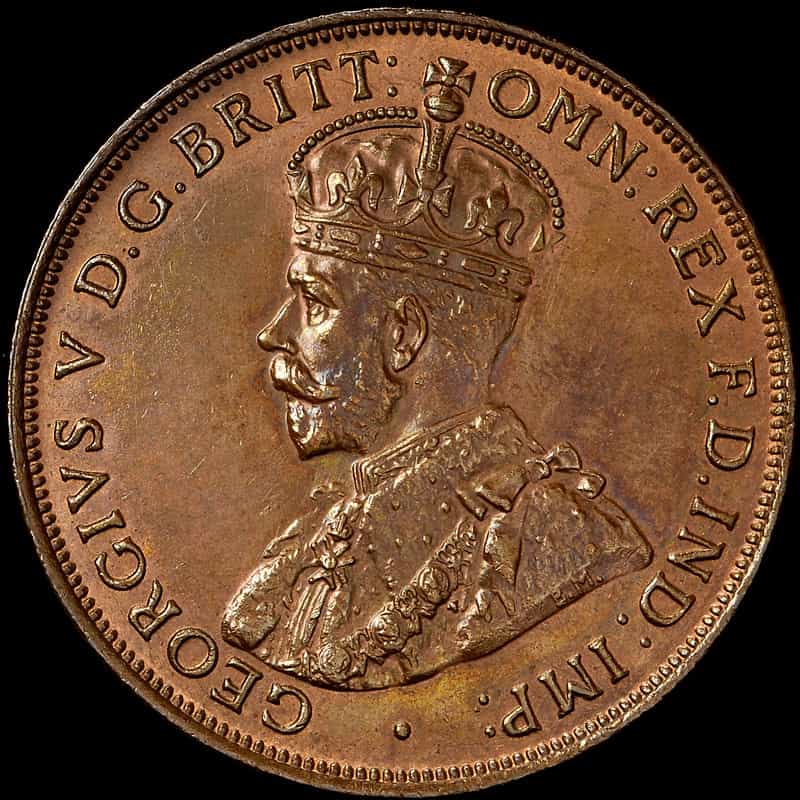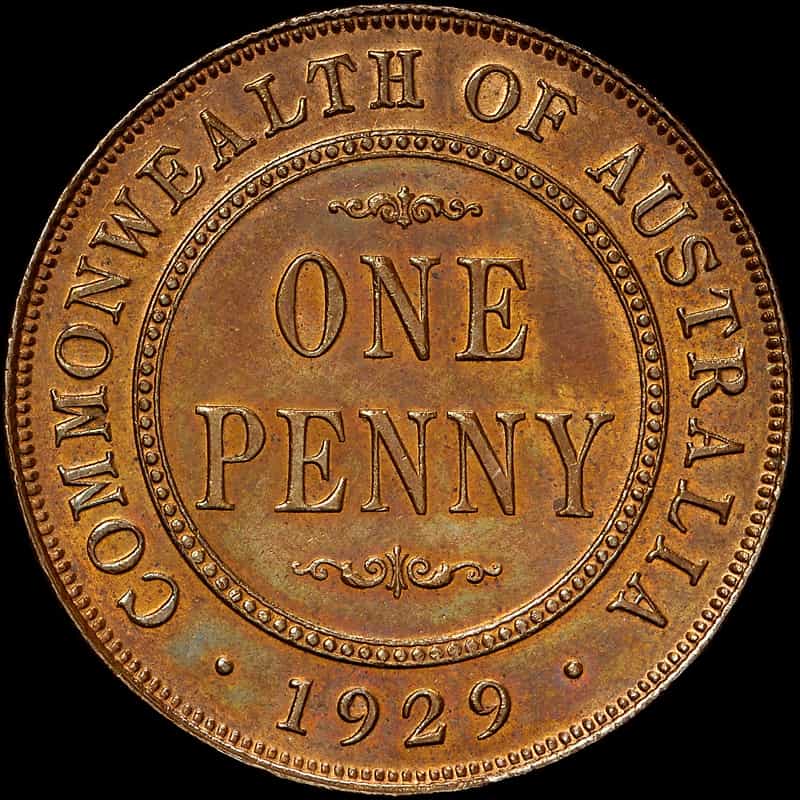Australia 1929 Penny (Indian Obverse)
| Mint: | Melbourne | Mintage: | Part 1,834,600 Estimate 50,000 | Milling: | Plain |
| Weight: | 9.45 grams | Diameter: | 30.8 mm | Composition: | 97% Copper, 2.5% Zinc, 0.5% Tin |
|
Click to enlarge
Wear
Next
Prev

Obverse 2 - Indian (Calcutta)
|
Click to enlarge
Wear
Next
Prev

Reverse Am - London (melbourne modified)
|
||||||||||||||||||||||||||||||||||||||||||||||||||||||||||||||||||||||||
|
|
||||||||||||||||||||||||||||||||||||||||||||||||||||||||||||||||||||||||
| Click on Wear to show high points first susceptible to wear | |||||||||||||||||||||||||||||||||||||||||||||||||||||||||||||||||||||||||
Value
|
BM
Ad
NP
|
8
Good
VG10
|
10
VG
F12
|
12
about F
F15
|
15
Fine
VF20
|
20
good F
VF25
|
25
about VF
VF30
|
30
Very Fine
VF35
|
35
good VF
EF40
|
40
about EF
EF45
|
45
Ext Fine
AU50
|
50
good EF
AU53
|
53
about Unc
AU55
|
58+
virt Unc
AU58
|
58-60
Uncirc
MS60
|
58-61
Uncirc
MS61
|
58-62
Uncirc
MS62
|
63-64
Choice Unc
MS63
|
64-65
near Gem
MS64
|
65-66
Gem
MS65
|
66-67
Gem
MS66
|
67-68
Gem
MS67
|
68
near Flaw
MS68
|
69
virt Flaw
MS69
|
70
Flawless
MS70
|
Proof
|
|---|---|---|---|---|---|---|---|---|---|---|---|---|---|---|---|---|---|---|---|---|---|---|---|---|---|
| B |
$1
+
NGC
PCGS
|
$3
+
NGC
PCGS
1
|
$5
+
NGC
PCGS
|
$10
+
NGC
PCGS
|
$15
+
NGC
PCGS
|
$25
+
NGC
PCGS
3
|
$50
+
NGC
PCGS
2
|
$75
+
NGC
PCGS
|
$100
+
NGC
PCGS
2
|
$150
+
NGC
PCGS
2
|
$200
+
NGC
PCGS
1
|
$300
+
NGC
PCGS
6
|
$500
+
NGC
PCGS
2
|
$900
+
NGC
PCGS
|
$1250
+
NGC
PCGS
|
$1500
+
NGC
PCGS
3
|
$3000
+
NGC
PCGS
6
|
$5000
+
NGC
PCGS
2
|
$9000
+
NGC
PCGS
|
$17500
+
NGC
PCGS
|
$35000
+
NGC
PCGS
|
-
+
NGC
PCGS
|
-
+
NGC
PCGS
|
-
+
NGC
PCGS
|
Y
|
| RB |
"
+
NGC
PCGS
|
"
+
NGC
PCGS
|
"
+
NGC
PCGS
|
"
+
NGC
PCGS
|
"
+
NGC
PCGS
|
"
+
NGC
PCGS
|
"
+
NGC
PCGS
|
"
+
NGC
PCGS
|
"
+
NGC
PCGS
|
$250
+
NGC
PCGS
|
$350
+
NGC
PCGS
|
$600
+
NGC
PCGS
|
$1000
+
NGC
PCGS
|
$1500
+
NGC
PCGS
|
$1750
+
NGC
PCGS
|
$3500
+
NGC
PCGS
1
|
$6000
+
NGC
PCGS
1
|
$10000
+
NGC
PCGS
2
|
$20000
+
NGC
PCGS
1
|
$37500
+
NGC
PCGS
|
-
+
NGC
PCGS
|
-
+
NGC
PCGS
|
-
+
NGC
PCGS
|
-
+
NGC
PCGS
|
Y
|
| R |
"
+
NGC
PCGS
|
"
+
NGC
PCGS
|
"
+
NGC
PCGS
|
"
+
NGC
PCGS
|
"
+
NGC
PCGS
|
"
+
NGC
PCGS
|
"
+
NGC
PCGS
|
"
+
NGC
PCGS
|
"
+
NGC
PCGS
|
"
+
NGC
PCGS
|
"
+
NGC
PCGS
|
"
+
NGC
PCGS
|
-
+
NGC
PCGS
|
-
+
NGC
PCGS
|
-
+
NGC
PCGS
|
-
+
NGC
PCGS
|
-
+
NGC
PCGS
|
-
+
NGC
PCGS
|
-
+
NGC
PCGS
|
-
+
NGC
PCGS
|
-
+
NGC
PCGS
|
-
+
NGC
PCGS
|
-
+
NGC
PCGS
|
-
+
NGC
PCGS
|
Y
|
BM
Benchmark
Ad
Adjectival
NP
NGC/PCGS
Collectable grades
Does not exist by definition
Investment grades
-
Unlikely to exist
Aspirational grades
BV
Bullion or metal value
Not known in these grades
''
Value as above
Proof
Y (Yes)
N (Not known)
N (Not known)
Last updated April 2024
Notes:
W.J. Mullet, who was a senior officer at the Melbourne Mint, wrote in 1981 that only one Indian obverse die was used in this year. If we refer to the averages being achieved from general production at the time, it can be deduced that the mintage of this coin was probably less than 50,000. This was the first use of the Indian obverse master die that was sent directly to Melbourne from London in 1922. Dies derived from this master were later used to strike the Indian die 1930 pennies. A study of the reverse used on both types of 1929 pennies also reveals its close resemblance to the 1930 pennies, but it is the 1929 English Penny reverse with the small void in the '9' of the date which is the closest match. It seems logical that the last two digits were removed from a 1929 reverse master which was then used to produce the 1930 pennies. Author and collector Dr David L. Briggs states in his publication "Australian Copper (Bronze) Coins 1911 -1964" that two 1929 'Indian Die' proof coins exist. Proof-like coins have been sighted that do not exhibit the wire rims associated with the double-struck proofs of the era, so it is more than likely that these are also early proof-like specimen strikes off the experimental die.
